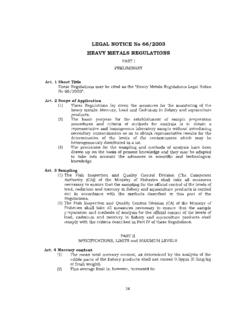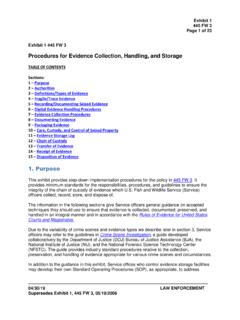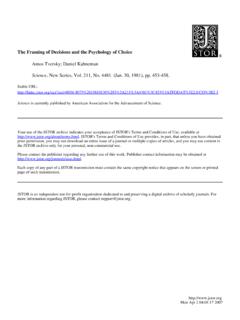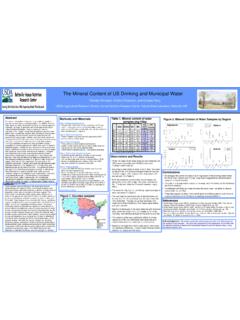Transcription of A Basic Guide to Thermocouple Measurements
1 Application Report SBAA274 September 2018. A Basic Guide to Thermocouple Measurements Joseph Wu ABSTRACT. Thermocouples are common temperature sensors used in a wide variety of commercial and industrial applications. While slightly less accurate than resistance temperature detectors (RTDs), thermocouples cover a wide temperature range, are self-powered, and have a fast response time. Their simple construction make them inexpensive and durable. Because of the small sensor voltage and low noise requirements, delta-sigma analog-to-digital converters (ADCs) are ideal data converters for measuring thermocouples. This application report gives an overview of thermocouples, discussing theory of operation, functionality, and methods in temperature measurement. Many circuits are presented showing Thermocouple connections to precision ADCs.
2 Different topologies focus on biasing thermocouples for the ADC input and for burn-out Measurements . Contents 1 Thermocouple Overview .. 3. 2 Thermocouple Measurement Circuits .. 14. 3 Summary .. 36. List of Figures 1 Thermocouple Voltage .. 3. 2 Thermocouple Responses .. 4. 3 Thermocouple Construction Types .. 6. 4 Type-K IEC-EN 60584-2 Tolerance Class Errors .. 8. 5 Resistor Biasing of a Thermocouple .. 10. 6 Voltage Biasing of a Thermocouple .. 10. 7 Thermocouple and Cold-Junction Measurement Conversion to Temperature .. 11. 8 Comparison of Interpolation Errors Using Various Lookup Tables .. 12. 9 Burn-out Detection Using Resistor Biasing .. 13. 10 Burn-out Detection Using BOCS .. 13. 11 Thermocouple Measurement Circuit With Pullup and Pulldown Resistors .. 15. 12 Thermocouple Measurement Circuit With Biasing Resistors Attached to the Negative Lead.
3 17. 13 Thermocouple Measurement Circuit Using VBIAS For Sensor Biasing and Pullup Resistor .. 19. 14 Thermocouple Measurement Circuit With VBIAS for Sensor Biasing and BOCS .. 21. 15 Thermocouple Measurement Circuit With REFOUT Biasing and Pullup Resistor .. 23. 16 Thermocouple Measurement Circuit With REFOUT Biasing and BOCS .. 25. 17 Thermocouple Measurement Circuit With Bipolar Supplies and Ground Biasing .. 27. 18 Thermocouple Measurement Circuit With Two-Wire RTD Cold-Junction Compensation .. 29. 19 Thermocouple Measurement Circuit With Thermistor Cold-Junction Compensation .. 31. 20 Thermistor and Linearization Responses Over Temperature .. 32. 21 Linearization of Thermistor With Parallel Resistor and Voltage Divider .. 32. 22 Linearized Output of Thermistor Circuit .. 33. 23 Thermocouple Measurement Circuit With Temperature Sensor Cold-Junction Compensation.
4 34. List of Tables SBAA274 September 2018 A Basic Guide to Thermocouple Measurements 1. Submit Documentation Feedback Copyright 2018, Texas Instruments Incorporated 1 Common Thermocouple Types .. 4. 2 Characteristics of ITS-90 Thermocouple Direct Polynomials to Determine Voltage from Temperature .. 5. 3 ITS-90 Temperature Coefficients for a K-Type Thermocouple .. 5. 4 Thermocouple Tolerance Class Information .. 7. 5 Conversion From Voltage to Temperature for the LMT70 .. 35. Trademarks All trademarks are the property of their respective owners. 2 A Basic Guide to Thermocouple Measurements SBAA274 September 2018. Submit Documentation Feedback Copyright 2018, Texas Instruments Incorporated Thermocouple Overview 1 Thermocouple Overview Thermocouples are temperature measurement sensors that generate a voltage that changes over temperature.
5 Thermocouples are constructed from two wire leads made from different metals. The wire leads are welded together to create a junction. As the temperature changes from the junction to the ends of the wire leads, a voltage develops across the junction. Combinations of different metals create a variety of voltage responses. This leads to different types of thermocouples used for different temperature ranges and accuracies. Choosing a Thermocouple often is a function of the measurement temperature range required in the application. Other considerations include the temperature accuracy, durability, conditions of use, and the expected service life. Seebeck Voltage In 1820, Thomas Johann Seebeck discovered that when a metal bar is heated on one end, a voltage (known as the Seebeck voltage) develops across the length of the bar.
6 This voltage varies with temperature and is different depending on the type of metal used in the bar. By joining dissimilar metals that have different Seebeck voltages at a temperature sensing junction, a Thermocouple voltage (VTC) is generated. The dissimilar metals are joined at a temperature sensing junction (TTC) to create a Thermocouple . The voltage is measured at a reference temperature (TCJ) through the two metals. The leads of the Thermocouple are required to be at the same temperature and are often connected to the ADC through an isothermal block. Figure 1 shows a Thermocouple constructed from two dissimilar metals with the Thermocouple leads connected to an isothermal block. metal A. +. Thermocouple VTC. TTC.. metal B. TCJ. Isothemal Cold-Junction Block Figure 1. Thermocouple Voltage The connection of the Thermocouple to an isothermal block is important for the temperature measurement.
7 For an accurate Thermocouple measurement, the return leads of different metals must be at the same known temperature. Any connection between two different metals creates a Thermocouple junction. Connections from the Thermocouple to the ADC should be simple and symmetric to avoid unintentional Thermocouple junctions. These additional junctions cause measurement errors. As the Thermocouple signal connects to the ADC integrated circuit, each step along the path can encounter several additional thermocouples. This becomes a measurement problem if there is a temperature gradient across the circuit. Each connection from wire terminal, to solder, to copper trace , to IC pin, to bond wire, to chip contact creates a new junction. However, if the signal is differential, and each of the Thermocouple pairs are at the same temperature, then the Thermocouple voltages cancel and have no net effect on the measurement.
8 For high-precision applications, the user must ensure that these assumptions are correct. Measurement with differential inputs include unintentional Thermocouple voltages that do not cancel if the thermocouples are not located close together, or if there is a thermal gradient on the board or device. SBAA274 September 2018 A Basic Guide to Thermocouple Measurements 3. Submit Documentation Feedback Copyright 2018, Texas Instruments Incorporated Thermocouple Overview Thermocouple Types Common Thermocouple Metals All dissimilar metals used to construct a Thermocouple display a change in voltage from the Seebeck effect, but several specific combinations are used to make thermocouples. The thermocouples can be classified into two different construction types: base metal thermocouples and noble metal thermocouples.
9 Base metal thermocouples are the most common thermocouples. Noble metal thermocouples are composed of precious metals such as platinum and rhodium. Noble metal thermocouples are more expensive, and are used in higher temperature applications. Regardless of metal lead, each Thermocouple type is designated a single letter to indicate the two metals used. For example, a J-type Thermocouple is constructed from iron and constantan. With each type, the thermoelectric properties are standardized so that temperature Measurements are repeatable. Thermocouple leads and connectors are standardized with color plugs and jacks, indicating the type of Thermocouple . Different colors for insulation and lead wires also indicate the Thermocouple grade and extension grade. Table 1 lists several common Thermocouple types and their characteristics.
10 Table 1. Common Thermocouple Types Thermocouple Lead metal Lead metal Temperature EMF over Seebeck Type A (+) B ( ) Range ( C) Temperature Coefficient Range (mV) ( V/ C at 0 C). J Iron Constantan 210 to 1200 to K Chromel Alumel 270 to 1370 to T Copper Constantan 200 to 400 to E Chromel Constantan 270 to 1000 to S Platinum and Platinum 50 to 1768 to 10% Rhodium Thermocouple Measurement Sensitivity The National Institute of Standards and Technology (NIST) has analyzed the output voltage versus temperature for the various types of thermocouples. Figure 2 illustrates the typical responses for these same Thermocouple types. 80. Type J. Type K. Type T. Thermocouple Voltage (mV). 60. Type E. Type S. 40. 20. 0. -20. -400 -200 0 200 400 600 800 1000 1200 1400 1600 1800. Temperature (qC). Figure 2. Thermocouple Responses Several polynomial equations are defined by the International Temperature Scale of 1990 (ITS-90).
















